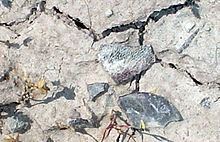Region North America | Overlies Smiths Formation | |
 | ||
Thickness 1,344 meters in western Tincup Canyon area, Caribou County | ||
The Wayan Formation is a geological formation in Idaho whose strata date back to the latest Early Cretaceous and the earliest Late Cretaceous. Dinosaur, other reptile, mammal, and micro and macro-floral remains are among the fossils that have been recovered from the formation. The lack of extensive outcrops, limited geographic extent, and extreme structural deformation have limited paleontological explorations of the Wayan.
Contents
Geology and Age
The Wayan occurs in the Caribou Mountains of eastern Idaho. Sediments are dominantly floodplain mudstones (many having undergone extensive pedogenic processes) with some fluvial sandstones and minor conglomerates, limestones, and tuffs. Carbonate nodules in pedogenic mudstones suggest a semi-arid, seasonal climate during deposition. Radiometric U-Pb dates from detrital zircons indicate a latest Albian to early to middle Cenomanian age. Detrital zircon U-Pb dating within one stratigraphic meter of an Oryctodromeus locality yielded an age of 99.1 +1.5/-1.3 Ma showing proximity to the Albian/Cenomanian stage boundary.
The Wayan is equivalent to the upper Cedar Mountain Formation of Utah, the Aspen Shale of Wyoming, and the Vaughn member of the Blackleaf Formation of Montana.
Fauna and Flora
The vertebrate fauna is dominated by the small basal ornithopod Oryctodromeus, which dominates the vertebrate assemblage and is known from several partial skeletons. An ankylosaur, a Tenontosaurus-like iguanodontid, a hadrosaurid, dromaeosaurs, a tyrannosauroid, a possible neovenatorid allosauroid, a giant oviraptorosaur (represented by eggshell of the oogenus Macroelongatoolithus carleylei), indeterminate small theropods, possible neoceratopsians, large and small crocodilians, turtles, a variety of small mammals, and semionotid fish are known from very fragmentary remains.
Fossil plants are rare, but petrified conifer wood, and foliage from angiosperms, conifers and ferns has been reported.
Vertebrate Fauna
Macroflora
Taphonomy
Taphonomic modes of the Wayan are distinct. Fossiliferous 'pods' of Oryctodromeus skeletons and skeletal elements, sometimes with more than one individual represented, are the most common occurrence of vertebrate skeletal remains. Degrees of association and articulation range from fully articulated individuals to articulated strings of vertebrae and articulate limbs associated with other elements. These Oryctodromeus remains exhibit no appreciable pre-burial taphonomic modifications such as weathering, abrasion, breakage, or tooth marks. This combination of observations suggests the possibility of burial of these animals within unrecognized burrows.
Excluding eggshell, almost all other vertebrate remains known from the Wayan occur as isolated teeth and partial to complete bones found in high energy fluvial lag and possible debris flow deposits. These remains exhibit a more typical range of taphonomic modification with varying degrees of abrasion and breakage typical of skeletal remains preserved in fluvial deposits. The overall fossil assemblage of the Wayan and patterns of preservation suggest that surface processes on the Wayan floodplains were less conducive to preservation, with preservation typically occurring subsurface and in fluvial channels.
